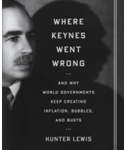Translating deep thinking into common sense
Was Keynes a Quack?

By Vinay Kolhatkar
October 20, 2014
SUBSCRIBE TO SAVVY STREET (It's Free)
A Book Review
According to TIME magazine, “John Maynard Keynes–tall, charming and self-confident—nonetheless transformed the dismal science into a revolutionary engine of social progress,” prescribing that Governments should spend the money they don’t have to revive economies that are stagnating. The Economist reminded us that Keynesian solutions, “particularly the use of fiscal stimulus, have been adopted on a dramatic worldwide scale.”
The quackery of Keynesianism laid bare
Hunter Lewis is a Circle Bastiat contributor on Mises.org, and the author of several bestselling books, including the widely acclaimed Are the Rich Necessary and the well-researched Crony Capitalism in America.
Lewis laments the fact that not enough literature exists that rebuts Keynes directly. Friedrich Hayek apparently planned one but gave up because Keynes so frequently changed his mind, that Hayek thought it would be a waste of time. Lewis has high regard for Henry Hazlitt’s comprehensive takedown in his 1959 epic The Failure of the New Economics. Hazlitt, however, exposed the inconsistencies and fallacies by going through The General Theory of Employment, Interest, and Money, Keynes’ magnum opus, line by line, resulting in a 500-page classic.
Dedicating his book to Henry Hazlitt, Lewis decides to concentrate on the major fallacies, and even then  ends up with over 300 pages plus endnotes. In part, this is because of the book’s unusual structure, and in part, this is because, as Hazlitt found, there are simply too many absurdities to cover. Part I of the book is a 10-page introduction. Part II is about what Keynes actually said. Part III is the rebuttal. Part IV looks at Keynes the person, going beyond his magnum opus, perusing the so-called master’s Essays of Persuasion, what his colleagues and biographer experienced, and Keynes’ extensive use of various misleading devices such as obscurity, shifting definitions, misuse of mathematics, cause-effect reversals, and unsupported assertions. In Parts V and VI, Lewis concludes his book by demonstrating the pervasive influence of Keynesianism and its horrendously deleterious effects on contemporary economies.
ends up with over 300 pages plus endnotes. In part, this is because of the book’s unusual structure, and in part, this is because, as Hazlitt found, there are simply too many absurdities to cover. Part I of the book is a 10-page introduction. Part II is about what Keynes actually said. Part III is the rebuttal. Part IV looks at Keynes the person, going beyond his magnum opus, perusing the so-called master’s Essays of Persuasion, what his colleagues and biographer experienced, and Keynes’ extensive use of various misleading devices such as obscurity, shifting definitions, misuse of mathematics, cause-effect reversals, and unsupported assertions. In Parts V and VI, Lewis concludes his book by demonstrating the pervasive influence of Keynesianism and its horrendously deleterious effects on contemporary economies.
Part II consists of excerpts mainly from The General Theory, followed by a commentary on what Keynes most likely meant, with a brief on how that meaning has been derived. Simply getting to what Keynes actually meant is rendered difficult because The General Theory is very badly written; even his famous pupil Paul Samuelson, a life-long Keynesian himself, admitted that as much.
In Part III, the same excerpts are taken up again, but this time with the rebuttals. In the paradigms of common-sense, free-market economics, Keynes is very easily refuted.
These are some of the Keynesian inferences that are taken up for a comprehensive dismissal. It is hard to say which of these Keynesianisms are the most ludicrous:
2. The stock market behaves like a casino;
3. The State should decide the volume of investment;
4. In an economic crisis, federal agencies should print or borrow money, and then spend it to get the economy to recover;
5. Gold is a barbarous relic;
6. Consuming more will lead to higher investment;
7. Commodity prices should be managed by the State; and
8. Markets do not self-correct.
These are not the only preposterous statements that Lewis has to deal with. Part III runs into 165 pages of refutation, and absolute repudiation, of what is essentially The General Theory’s whimsical, and full frontal, assault on the price system, plus its inconsistencies, arbitrary assertions, and serious logical problems. Part III is the crux of this work, and it is extremely well done. It is accessible to anyone with a basic grounding of Austrian or classical theory, and an understanding of the importance of prices determined in a free market.
Although Lewis achieves his intended mission overall, I have three misgivings:
1. The unusual structure—the chapter headings in Part II and III are the same except the two digressions in each of Part II and III. The reader does not have to wade through 68 pages of what Keynes said before getting to the repudiation in Part III, but many readers will tend to read chapters in a sequential fashion. A better structure would have been to combine the two sections by attacking the assertions in the same chapter as they are enumerated, as well as specifying how the assertions were arrived at (which admittedly is quite a task in itself, given the obscurity with which Keynes spoke and wrote).
Keynes demolished and his quack system refuted
2. There is an astonishing inconsistency in the take-home sentiment that Lewis leaves us with. On the one hand, he hopes that Keynes will be relegated to the position of false utopians like Marx and Mao, and carries a back cover recommendation which loudly proclaims ”Keynes demolished and his quack system refuted”. However, Lewis is academically reverential in the praise of Keynes’ wit and writing skills, and for the most part, states that Keynes was merely “wrong” (including in the book title), rather than diabolical or horribly confused. Yet Lewis is also happy to quote Keynes’ biographer in ways that suggests a very sinister motive.
A peek into how he was able to manipulate conformity around his views
3. Part IV, a small, 11-page account over three chapters, begins to address the crucial issue of John Maynard Keynes, the person. We get a peek into how he was able to manipulate conformity around his views, and whether the man himself truly believed what he had put out. Yet, even as this glorious beginning excites, it does not anywhere near consummate the extremely critical task of unraveling the mystery of how a quack became a superstar, and set economic science back by hundreds of years. Without an understanding of that, the benevolent will have a hard time undoing the pervasive damage done by this charlatan to the canons, methodology, and craft of rational economic science into what passes as mainstream economics today.
Nevertheless, a concise disassembly of Keynes was long overdue, and Lewis’ book does precisely that. It should form part of the arsenal of every student of real economic science.








